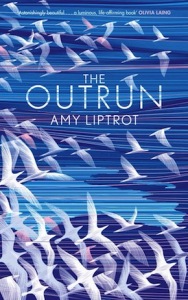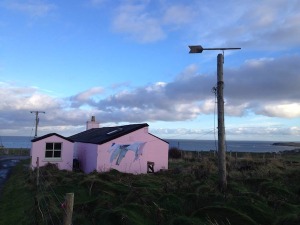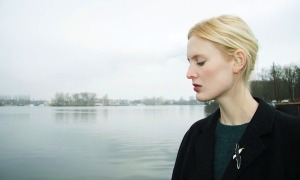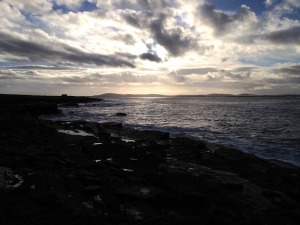Connections
by Amy LiptrotWhen I arrived at Rose Cottage, I made sure broadband was working before the hot water. I’m medieval with Wi-Fi: concentrating on the fundamentals of making fire and baking bread while becoming increasingly reliant on my smartphone.
Wherever I am, I spend most of my time with a laptop online, so I might as well do it in the calm and beautiful surroundings of Papay. In the past decade or so, the internet has made island life possible for more people, able to work remotely for employers down south. This way of working increases hope that the fragile populations of some of the smaller islands will not only stabilise but grow. The internet can be more important to remote communities than it is in cities. Since I’ve been sober and in Orkney, I’m online more than ever as a way of keeping myself linked to the old life I’m not prepared to cut ties with. I’m keeping in spectral communication with the ghosts of my past.
In the islands in the age of digital media, we often find that, although it seems contradictory, technology can bring us closer to the wild.”
There can be connection problems. Our internet on Papay comes through the copper phone lines as the population size does not justify the phone companies installing fibre-optic cables. The signal is sent by microwaves from Kirkwall to Shapinsay to Sanday to Westray then to us, declining in speed with each transition. The mobile signal can be affected by the wind, and one side of the island gets the Orange signal, the other O2. I’m waiting for the next gale to receive my text messages.
In the islands in the age of digital media, we often find that, although it seems contradictory, technology can bring us closer to the wild. When an unusual bird, such as a sea eagle, is seen in the sky above Orkney, or a pod of orca along the coastline, people pass messages immediately via a local birding forum or text-message groups so that others can rush out to see them. Alerts on the possibilities of seeing the Merry Dancers circulate on the social networks and, the next day or the same night, people share their photographs.
On Sanday, a webcam is trained on the colony of grey seals that pup in November. I post a link on Facebook and my friends in offices in London watch the hulking grey females hauled up on the beach with their white teddy-bear-like pups, unable to swim yet. We chat while watching seals caught before dawn by night-vision camera and a black-backed gull eating a seal’s afterbirth.
I think of Maggie and her lifelong connection to a place; her memories of names and houses on the island were similar to the way I can place people I know to different corners and times of the internet. Many of them I’ve never met in person but we’ve vaguely followed each other’s lives for years. Often I feel as if my real life is inside the computer while my time back in Orkney and the people I see here are just a temporary intrusion. I know people on Twitter I’ve never met better than people I’ve sat opposite for months at work or people I went to school with. I’ve moved around a lot but the internet is my home.
I begin to use a GPS app on my phone to track my daily walks around Papay, along sheep trails and high-water lines. I’m building a map, within the limits of the island, revealing the lines I am drawn along. Overlaid on satellite maps, a story emerges. The GPS tracks show how my walks change. At first I stride out, covering good distances along the coastal paths, marking my territory. As the weeks go on, I become slower and more exploratory, covering smaller areas in greater detail: climbing down the stones into a geo, looking in rockpools for treasures.
Cross-referencing the shoreline with the Ordnance Survey map in my pocket, Google Maps on my phone and my physical and visual experience, I am locating myself, putting the correct names to the inlets and outcrops around the North Hill. The Pow of Keldie looks like a potential spot to swim at low tide; Mad Geo is dark and intense. For me, these places – ‘The Sneck’, ‘Eerival’ – exist both digitally and underfoot.
Orkney and Shetland often used to appear in a box at the side of the map, to the east of Britain rather than the north. Now Google Maps stretches endlessly around the globe. Late at night, I keep ending up on the Wikipedia page for and satellite view of Sule Skerry, to the west of the Outrun, just beyond the horizon, home in the spring to thousands of breeding puffins and gannets. It seems the tides are strong around these parts of the internet, pushing me back here again and again.
With the Sky Map app, I am able to point my phone at the night sky and name which stars and planets are in that direction. One night, a friend asks me what that bright star is, and when I answer that I think it’s not a star but Jupiter, the app confirms that I am correct, improving my confidence in my meagre astronomy knowledge. The programme marks the horizon, like a spirit level, providing a digital gravity even on the windiest, darkest night. Down there, on the other side of the world, is the International Space Station, only visible to people in the southern hemisphere tonight. Astronauts on-board tweet photographs of their view back to us on earth and people reply with long-exposure images they took of the station passing above, a trail of light across the continents.
One morning, I have a tip-off on Facebook that orca have been seen hunting dolphins along the west coast of Orkney, heading north. I go out to the North Hill and look for them. I am all eyes, my body efficiently insulated. I don’t see any whales but I watch a huge ship just disappearing from view. I think it must be an oil tanker heading out to one of the North Sea oil platforms but, back at the cottage, I look on the marine-traffic website and find that she is Russian cargo ship Kuzma Minin, with a destination of Kandalaksha in northern Russia. The flight-radar website tells me that the contrail high above Westray one clear dawn is the overnight Lufthansa flight from Los Angeles to Frankfurt.
The more I take the time to look at things, the more rewards and complexity I find. Long-exposure photographs glow supernaturally. With all these tabs open on my browser, I feel omniscient, watching how global-transport logistics dance and intersect, never crashing, like flocks of starling.
***
I am not tracking a mysterious or endangered species: I am carrying out semi-scientific studies into myself, performing bathymetry of the soul.”
Seabirds have been caught and fitted with satellite tracking devices, GPS data loggers, finding out, often for the first time, just how far they travel searching for food. One fulmar tagged by Yvan and Juliet on Copinsay was found to have flown as far as Norway before returning to its nest. The corncrakes were tracked to Africa with daylight geolocators, which stopped working when they finished their migration and again found shelter in long foliage, blocking exposure to the daylight. While kayaking this summer, Mum saw a basking shark in Scapa Flow, anecdotally a species increasing in numbers in our seas. Aiming to quantify these stories, researchers have fitted twenty basking sharks on the west coast of Scotland with trackers and we are able to watch their movements in close-to-real time on the internet.
I am not tracking a mysterious or endangered species: I am carrying out semi-scientific studies into myself, performing bathymetry of the soul. My last.fm counts every song I listen to, constantly updating lists of my favourite artists and recommending new ones. My Facebook prioritises the friends I interact with. I jostle for retweets and edgerank. I am in an ever-changing process of defining myself, fascinated by counting and plotting and marking my daily activities and movements, collecting bottomless data. I’ve been tracking my sleep cycles and carrying out surveys of my dreams. I download a menstrual-cycle recorder and watch it sync with the moon, waxing and waning in another window on my browser.
With my phone, I record the noise of the wind and rain on my Rose Cottage bedroom window late one night during a gale. According to my dosimeter – the noise-measuring app on my phone – the sound of the weather is averaging 68 decibels from my bed, about the level of a loud conversation, making it hard to sleep. I remember these noises from my childhood bedroom at the farm. I remember shouting into ears in nightclubs, trying to be heard above the music. Tonight the wind and my phone are my companions.
I record the sound of the breaking waves at Fowl Craig, the greylag geese that sometimes mysteriously honk and rise late at night, wind in the telegraph wires and the familiar hum of the propeller plane. I upload my recordings to the internet – twenty-second sensory postings from my island life, like poems.
***
Sometimes, though, the internet – all this hyper-connection – just makes me lonelier. Chatting on Skype, looking at the screen rather than the camera, creates a shifty dissociation, a not-quite eye-contact. Meeting in real life, we are unsure, blinking and leaving too long before responses. We spend too much time online and real life is just another window. What’s the point in going out to look at wildlife when I can watch nature documentaries on YouTube, in bed with an electric blanket?
I half wake in the night with rootless anxiety and grasp for my phone. The internet is still a place I turn to for comfort and I used to post online when I had been drinking. Lately, I have been tidying up trails I left in different parts of the internet under multiple identities, some years ago, while drunk. I used to spill my heart over the internet like red wine.
‘Cross-addiction’ is the idea that, in the absence of drink, alcoholics will transfer their addictive behaviour to something else. It’s commonly seen with food, exercise, shopping or gambling. For me, it’s Coca-Cola, smoking, relationships and the internet. Sometimes I am smoking one cigarette while craving the next. I can fixate on a new friend and escape into their internet profiles, wanting to obliterate my personality with theirs.
There’s an emptiness. I’ve lost booze and I am desperately searching for what I need to fill me up. Is it coffee, sex, writing, love, new clothes or online approval? I read about how these beeps and notifications and vibrations affect and alter our brains, giving small jolts of dopamine, a little adrenaline. Searching for that tiny buzz, I am circling round familiar websites, like a migrating bird following rivers or motorways. The red notification of a message I’ve been waiting for gives a shadow of the sensation of the first sip of beer, of cold water when you’re parched, of a soft bed when you’re exhausted, of giving up swimming when you’re ready to drown.
I’m trying to find the right thing to fill this hole but it always eludes me, just at the brink of my consciousness – the island just over the horizon.”
I have twenty tabs open, each an endless journey, an unfinished thought. I can’t go to sleep yet: there are too many tabs open in my brain. This thirst feels unquenchable. I read old emails dozens of times, trying to find something that’s not there any more. I’m trying to find the right thing to fill this hole but it always eludes me, just at the brink of my consciousness, the corner of my eye, the thing you went to pick up but then found you couldn’t remember what it was – the island just over the horizon.
In this emptiness, I miss alcohol. I miss drink like I missed my boyfriend. I begin to think that maybe AA is like the fundamentalist Christian camps in the US where gay people try to become straight. Maybe it is cruel and unnatural to force me from my path as an alcoholic. I don’t remember excessive drinking in our house when I was a child, although I know that Dad drank more when he was high. As soon as I started drinking as a teenager, though, I did so with a dangerous urgency. The pieces were already in place for me to be a drinker and now it hurts to be made to do otherwise.
At least alcohol gives a quantifiable answer to the non-specific question: it fills a void. Without it, I am left to figure out what the question was – and that’s where AA suggests that its 12 Step Programme comes in. Step One: “We admitted we were powerless over alcohol – that our lives had become unmanageable.” I had done this some time ago, when I went into the treatment centre, but I have been reluctant to undertake the rest.
My time in treatment taught me to recognise feelings and to try to understand what certain types of behaviour are trying to achieve and what they actually will. I take a step back from my blank-minded mouse-clicking and notice how, when my phone runs out of batteries, I can almost feel I don’t exist, my walk no longer being tracked. I want to be able to use all this technology for its benefits but keep it under control, not be sucked under. I’m aware of my addictive and obsessive tendencies.
 I’m using technology to take myself to the centre of something from my spot at the edge of the ocean. I’m trying to make sense of my environment. With my digital devices, the planes and birds and stars seem more quantifiable and trackable. I’m trying to make a connection with the world outside Papay and my old life. I take a photograph of the sun setting over Westray and upload it to Facebook. My sky is converted into zeroes and ones, my personal data beamed to satellites, bounced through fibre-optic cables under the sea, through microwaves and copper wire, over islands, to you.
I’m using technology to take myself to the centre of something from my spot at the edge of the ocean. I’m trying to make sense of my environment. With my digital devices, the planes and birds and stars seem more quantifiable and trackable. I’m trying to make a connection with the world outside Papay and my old life. I take a photograph of the sun setting over Westray and upload it to Facebook. My sky is converted into zeroes and ones, my personal data beamed to satellites, bounced through fibre-optic cables under the sea, through microwaves and copper wire, over islands, to you.
Extracted from The Outrun, published by Canongate in hardback and eBook.
Read more.




